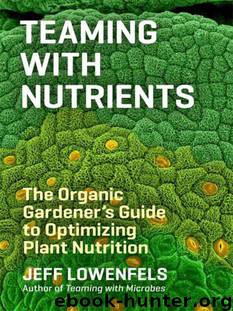Teaming with Nutrients: The Organic Gardener’s Guide to Optimizing Plant Nutrition by Lowenfels Jeff

Author:Lowenfels, Jeff [Lowenfels, Jeff]
Language: eng
Format: epub
Publisher: Timber Press
Published: 2013-05-06T21:00:00+00:00
The long hyphae of mycorrhizal fungi help plants obtain nutrients and water. In return, the fungus receives exudates from the plant.
These all-important root-fungi partnerships are known as mycorrhizae. (The fungi are mycorrhizal fungi; mycorrhiza refers to the relationship.) Somewhere between 90 and 96 percent of all plants enter into mycorrhizae. These are not trivial associations. Fungi produce powerful acids and enzymes that break down organic material, freeing tied-up nutrients, many of which are then moved to the host plant root. The plant, in turn, expends valuable energy and uses limited resources to make and deliver exudates to support the association.
Mycorrhizal fungi are best known for freeing phosphorus, which is so tightly bound to soil particles that little of it is readily available to plants. Although phosphorus is probably the nutrient most moved by them, nitrogen, copper, and zinc are also brought to the root by mycorrhizal fungi. (These guys will do almost anything in return for carbon.)
As more and more is learned about the role of mycorrhizae, it is becoming even clearer that the fungal partner plays a very important part when it comes to plant nutrients. For example, the number of nitrogen-fixing nodules in legumes increases in the presence of mycorrhizal fungi, and nitrogen released into the soil is retrieved and brought to the plant by the fungi.
The problem with plants enlisting biological help to obtain essential nutrients is that the process is not without its costs. The plant must expend energy and use limited resources to produce exudates. While most mycorrhizal fungi seem to form associations with more than one kind of plant, bacterial associations are quite specific to plant species as a result of the specific exudates produced by the plant to attract and support the necessary microbes. This dedication of DNA and RNA to the task of producing the necessary and specific plant exudates must be expensive. Perhaps this is why the specificity evolved. If you are going to associate, associate with the right organism.
Of course, in a gardener’s plant-centered world, all the creatures of the soil food web are involved in bringing nutrients to plants. The arthropods and other invertebrates of the soil food web aid in the decay of organic material, releasing some and assimilating other nutrients in their bodies until they, in turn, are decayed. Eventually the nutrients from the soil food web organisms as well as decayed plant matter enter the bodies of bacteria, Archaea, and fungi. When these are eaten, the resultant wastes, in the form of inorganic ions, become available to plants via interception, mass flow, and diffusion. Step back and admire this system!
Download
This site does not store any files on its server. We only index and link to content provided by other sites. Please contact the content providers to delete copyright contents if any and email us, we'll remove relevant links or contents immediately.
The Secret History by Donna Tartt(18846)
Goodbye, Things by Fumio Sasaki(8478)
Wonder by R. J. Palacio(8010)
Turbulence by E. J. Noyes(7936)
How to Be a Bawse: A Guide to Conquering Life by Lilly Singh(7391)
Kaplan MCAT General Chemistry Review by Kaplan(6867)
The Thirst by Nesbo Jo(6827)
The Testaments by Margaret Atwood(6773)
The Last Wish (The Witcher Book 1) by Andrzej Sapkowski(5391)
Spare by Prince Harry The Duke of Sussex(5072)
The Body: A Guide for Occupants by Bill Bryson(4974)
On Writing A Memoir of the Craft by Stephen King(4863)
The Rules Do Not Apply by Ariel Levy(4861)
Audition by Ryu Murakami(4850)
The Doodle Revolution by Sunni Brown(4687)
Gerald's Game by Stephen King(4582)
Adulting by Kelly Williams Brown(4487)
Millionaire: The Philanderer, Gambler, and Duelist Who Invented Modern Finance by Janet Gleeson(4376)
Housekeeping by Marilynne Robinson(4347)
